Harvard study on U.S. rental markets shows dwindling affordable housing
While rent prices vary by state and city markets, some tenants are being pushed out of more expensive states like Washington, in favor of more affordable housing elsewhere.
In Washington state, a record number of residents are finding it difficult to afford rental housing.
Washington state has an unemployment rate of 4.8 percent, despite a recent economic increase in the job market, according to the Employment Security Department.
In a 2023 Annual Homelessness Assessment Report to Congress, made by the Office of Community Planning and Development, 28,036 people in Washington have been recorded as homeless, according to the U.S. Department of Housing and Urban Development.
While 12.1 million renters throughout the country continue to spend more than 30 percent of their income on utilities and rent, numerous factors such as inaccessibility, climate risks and structural inadequacies continue to affect an already challenging market with rising operating expenses and interest rates, according to a report by Harvard University’s Joint Center for Housing Studies.
In Tacoma, the Fair Market Rent for 2024 lists a market value of $1603.00 for a one-bedroom living space, $1987.00 for a two-bedroom space. Landlords cannot exceed maximum income to rent ratios when determining a tenant’s eligibility, according to the City of Tacoma.
In addition, the Landlord Fairness Code Initiative, which passed in 2023, prohibits landlords from enacting unfair or excessive fees on tenants. The City of Tacoma requires the landlord to comply with tenant protection laws and give advanced notice of rent increases.
In the last decade, the total number of low-rent units under $600 per month in the U.S. has fallen by 2.1 million, with a loss of 230,000 units between 2021 to 2022. Whereas the total number of renters has reached 22.4 million, according to Harvard.
The vacancy rate in Washington is 3.7%, below the balanced rate of 7%, with an increase in rents and homelessness as a result, according to the Washington State Department of Commerce.
An analysis of 200 metro areas in the U.S. shows that Gen-Z will spend $144,557 on rent by the time they’re 30, while Millennials spent $126,477, according to RentCafe.
Logan Turner, a former resident of Kirkland, first moved out in 2021 and was paying $845 per month to live in a room of an owned house. For work, Turner worked at a local Asian restaurant as a server, earning $16 per hour, with an additional seven to eight dollars in tips.
“I looked at apartments all over, but I couldn’t afford anything other than to rent this room, even with the amount that I was making,” Turner said.

With a median rent of $1,300 in Kirkland at the time, he couldn’t afford an apartment alone, despite making $24 to $25 per hour with tips included. In 2022, Turner moved in with his partner in Lynnwood, where they paid $1330 per month for an unrenovated apartment. One-bedroom renovated apartments in the complex where they lived went for $1580 per month, according to Turner.
After undergoing surgery, switching jobs and spending two years in Lynnwood with his partner, who struggled to find employment for 6 months, they were given a notice of rent increase. Their utility bill also increased to $260 per month, more than doubling at the time.
“It got to a breaking point where Washington was no longer a sustainable place to live, because of the dramatically increasing rent,” Turner said.
As a result, they were driven out of the housing market in Washington and moved in with Turner’s family in an eight-person household in a farmhouse in Berthoud, Colorado with shared expenses.
Though the amount varies by city and local supply and demand, the average rent for an 835 square-foot apartment in Washington is $1,976, while the average for an 872 square-foot apartment in Colorado is $1,863, according to market trend data from RentCafe.
Rachael Pugh, 24, also lives at home with her family due to her inability to afford rent. While attending UWT, she pays for her tuition out of pocket. Her goal is to graduate without student loan debt.
Pugh works at a local coffee roastery, earning under $20 an hour with a typical 30-to-35-hour work week. She earns about $900 on a biweekly basis while taking two classes per quarter.
“They are letting me stay with them until I graduate, or maybe even a year after that depending on how the year goes, but they will soon be charging me rent. However, the rent will be a lot more reasonable than other apartments,” Pugh said.
Pugh’s parents plan to charge her $600 per month to rent her room, which will allow her to invest or save money that she doesn’t need to spend on various living expenses, like an unexpected $8000 bill for vehicle repairs, according to Pugh.
Like many Gen-Zers, Pugh hopes the housing market will crash, so she can afford a place with roommates.
“My first goal was to move out in 2020, my second goal was to move out in 2022, it’s 2024, and I might be able to move out in 2026 or 2027,” Pugh said.
Kuulei Ego, 23, a graduate student at Pacific University, rented a townhome with seven roommates during her time as an undergraduate in Forest Grove, Oregon.
She will move back to Hawaii with her parents when her lease is terminated. She has a future apartment lined up in Omaha Nebraska, for her Master’s program in Occupational Therapy, where she will be using FAFSA loans to cover her rent.
Ego is still considering the possibility of having roommates, with a one-year lease ahead. She plans to look for a job to help cover expenses if her schedule allows.
“I don’t see myself owning a house,” Ego said.
Many young Americans share the same sentiment as Ego about housing, while those who want to afford homes or land cannot.

‘Featured image’ “Tiny Apartments: Quality of Life.” by iMorpheus is licensed under CC BY 2.0. Photo by Creative Commons.






